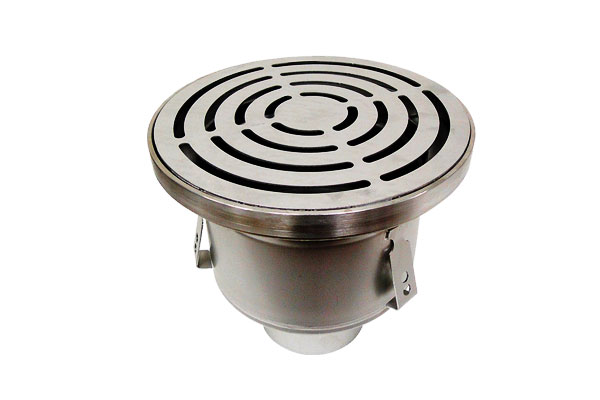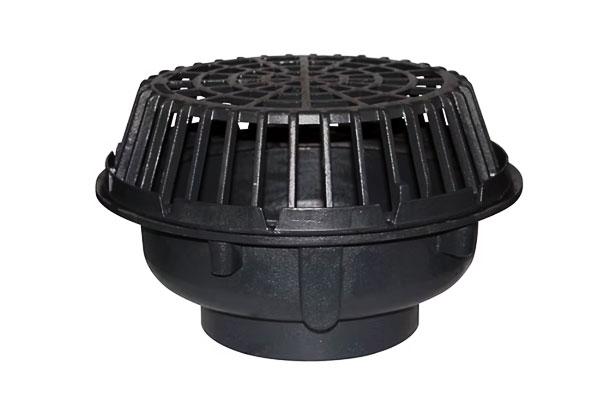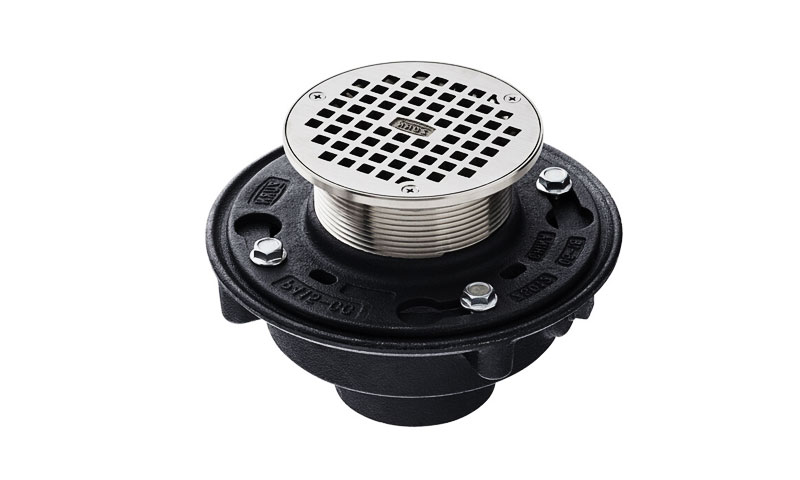1. Einführung
Stainless steel casting floor drains combine corrosion resistance, mechanical strength and hygienic surface properties that make them ideal for demanding commercial, industrial and food-processing environments.
Typical cast alloys (CF8/CF8M equivalents of 304/316) offer robust performance in wet, chloride-bearing and chemically aggressive services; specialty castings (Duplex rostfrei, cast 316L, or cast alloys with improved machinability) are used where service conditions, loads or regulatory requirements demand it.
Proper grade selection, Gussmethode, surface finish and installation determine long service life and low maintenance.
2. Why Choose Stainless Steel Casting Floor Drains?
Main advantages
- Überlegene Korrosionsbeständigkeit vs cast iron or coated steels — especially in chloride, alkaline or chemical washdown environments.
- Hygiene: stainless does not support microbial growth as readily as porous coatings; smooth finishes are easy to sanitize.
- Long life / Niedrige Wartung: less frequent replacement, lower risk of rust staining or structural failure.
- Recyclability and appearance: long serviceable life and attractive finish useful in public/commercial spaces.
When stainless is preferred
- Food and beverage processing, commercial kitchens, pharmaceutical and healthcare facilities, marine and coastal installations, chemische Pflanzen, and anywhere repeated wet cleaning, caustic detergents or salt exposure occurs.
3. Materialien & Grades Used for Cast Stainless Drains
The material selection for stainless-steel casting floor drains is critical for ensuring long-term corrosion resistance, mechanische Stärke, und Hygienekonformität.
The choice of grade depends on Serviceumgebung, Chemische Exposition, mechanische Belastung, fabrication requirements, und Kostenüberlegungen.
Gießen Edelstähle are preferred over wrought products in many cases due to the ability to produce complex shapes with integrated features such as traps, Sieben, and sloped surfaces.

Common Cast Stainless-Steel Grades
Cast stainless-steel grades are generally specified to ASTM A351 Standards. Below are the most frequently used alloys:
| Cast Designation | UNS -Nummer | Entsprechendes Äquivalent | Schlüsselmerkmale | Typische Anwendungen |
| CF8 | S30400 | 304 | Austenitisch; Ausgezeichnete allgemeine Korrosionsbeständigkeit; gute mechanische Stärke; wirtschaftlich | Indoor floor drains, general-purpose sanitary drains |
| CF8M | S31600 | 316 | Austenitic with 2–3% Mo; superior pitting and crevice corrosion resistance | Coastal, Marine, chemical plant, and food-processing drains |
| CF3 / CF3M | 304L / 316L gleichwertig | Low-carbon versions of CF8 / CF8M | Verbesserte Schweißbarkeit und geringeres Risiko einer Sensibilisierung | Welded installations, areas with onsite fabrication |
| Duplex Cast | S31803 / S32205 | Duplex Edelstahl | Mixed austenite–ferrite microstructure; hohe Stärke; excellent chloride resistance | Heavy-duty, Chemikalie, oder Hochchloridumgebungen; exterior or coastal installations |
| Special Machinable Castings | Variiert (Ni–Cu alloys, machinable CF8M) | - - | Alloyed for enhanced machinability; may have slightly lower corrosion resistance | Customized or precision drains requiring post-cast machining |
4. Casting processes and post-cast finishing

Common casting routes
- Investition (Lost-Wachs) Casting: yields excellent dimensional accuracy, Feines Detail (schmale Schlitze), and good surface finish — preferred for architectural/drain grates and precision trap bodies.
- Hülse / resin-bonded sand casting: cost-effective for moderate complexity parts with good finish; commonly used for housings and larger drain bodies.
- Green-sand casting: economical for large simple parts; may require more machining and finishing.
Post-cast operations
- Wärmebehandlung / Lösung anneal: relieves stresses and restores corrosion resistance after welding; recommended for many cast austenitics. Typical practice: solution anneal and quench per material spec.
- Bearbeitung and slot formation: drain slots, flange faces and trap interfaces machined to tolerance.
- Oberflächenbearbeitung: Schleifen, Satin -Finish, Perlenexplosion, elektropolisch. Surface roughness targets depend on hygiene requirements (see Section 7).
- Passivierung: Chemische Passivierung (Zitronensäure oder Zitronensäure) removes free iron and enhances the passive film; often specified after welding or fabrication.
5. Mechanisch & hydraulic design considerations
Load classes and structural strength
Floor drains must match expected loadings — pedestrian, light vehicle, or heavy-traffic.
For access covers and grates, many regions use IN 124 load classes as a reference (globally recognized):
- A15 — up to 1.5 T (pedestrian, bicycles)
- B125 — up to 12.5 T (car parks)
- C250, D400, E600, F900 — progressively larger loads (trucks, heavy industrial).
Guideline: choose drain tops/grates and seatings manufactured and certified to the appropriate load class.
For floor drains integrated into traffic areas, a cast duplex or thick CF8M grate may be required.
Hydraulikkapazität & grate design
- Slot area & free area: free area is the total open area through the grate; hydraulic capacity is directly proportional to free area for a given head.
Narrow slot designs (for safety/footwear) reduce capacity and increase clog risk. - Typical practice: ensure free area matches expected peak inflow (washdown or storm runoff) with margin; refer to local plumbing codes for sanitary or storm flow rates.
- Debris handling: incorporate trap baskets or removable strainers to collect solids and facilitate maintenance.
Trap seals and backflow prevention
- Internal traps prevent sewer gas entry. Where drains may be subject to backflow, consider backwater valves or floor check valves.
For high hygiene facilities, trap designs that are easy to remove and clean are preferred.
6. Korrosion, Tragen, and Contamination
Pitting and crevice corrosion — why 316 often wins
When chlorides or aggressive ions are present, the passivity of stainless steels can break down and localized corrosion (Lochfraß / Spalt) kann auftreten.
A quantitative index commonly used is Holz (Lochfraßfestigkeit Äquivalente Zahl).
Approximate PREN examples (typisch):
- 304 (CF8): Cr ≈ 18, Mo ≈ 0 → PREN ≈ 18
- 316 (CF8M): Cr ≈ 17–18, Mo ≈ 2–3 → PREN ≈ 26 (rund)
Higher PREN = better resistance to pitting / Spaltkorrosion. When drains are exposed to seawater, chlorine or brines, CF8M (gießen 316) is commonly recommended.
Galvanic contacts & Beschichtungen
Avoid mixing stainless drains with less noble metals (Zink, Aluminium, Kohlenstoffstahl) in electrical contact where stray currents or wet conditions exist, unless insulated; galvanic couples can accelerate corrosion of the less noble metal and cause staining.
Erosion and mechanical wear
High-velocity washdown (Z.B., Hochdruckreinigung) can erode drain slots and edges over time — robust castings or hardened inserts mitigate wear. Duplex castings provide higher strength and wear resistance.
7. Hygienic and cleanability aspects
Surface finish targets
- General commercial: brushed/satin finishes often acceptable (Ra ≈ 0.8 µm or 32 µin).
- Essen & pharmazeutisch: smoother surfaces are desirable (Ra ≤ 0.4–0.8 µm).
Electropolishing can reduce Ra to ~0.2–0.4 µm, minimize microcrevices and improve cleanability. - Welds and joints: glatt, continuous weld profiles facilitate cleaning; post-weld passivation recommended.
Drain geometry and bacterial control
- Avoid dead legs or stagnant pockets in trap bodies and housings. Sloped interior surfaces and smooth transitions promote self-draining and reduce microbial harborage.
Chemical compatibility with cleaners
- Choose drain grade compatible with the facility’s cleaning chemicals (Z.B., high-concentration chlorinated bleaches can attack some alloys at elevated temperatures). CF8M resists many common detergents and sanitizers better than CF8.
8. Installation best practices and site considerations

Montage & bedding
- Install drains on a true, prepared concrete recess with proper fall to the drain inlet. Bedding mortars should be compatible and should not entrap moisture against the cast body.
Schweißen & thermal effects
- If welding to stainless piping or frames, control heat input and consider post-weld solution anneal for CF8/CF8M attachments in critical sanitary applications to avoid sensitization.
Specify CF3/CF3M (niedrig c) where welding is frequent and sensitization is a concern.
Siegel & Dichtungen
- Use NSF/food-grade gaskets where required. Ensure seals are compatible with cleaning chemicals and temperatures.
Access for maintenance
- Provide adequate clearance and removable grates to access basket and trap for cleaning without disassembling adjacent equipment.
9. Inspektion, maintenance and troubleshooting
Routine checks
- Inspect and remove debris/strainers weekly in high-use areas; monthly checks in lower-use environments.
- Inspect for signs of pitting, Verfärbung, or weld crevice corrosion and address the cause (Chemikalie, mechanisch, or stray current).
Passivierung & Reinigung
- Periodic passivation (citric or nitric acid based) restores a clean passive layer after mechanical wear or welding. Electropolishing reduces maintenance frequency.
Common failure modes and remedies
- Pitting at slots or crevices: likely chloride exposure + insufficient alloy. Abhilfe: upgrade to CF8M or duplex, improve cleaning and drainage to prevent standing salts.
- Galvanic staining: isolate dissimilar metals or use sacrificial anodes.
- Mechanical damage to grate / Verformung: verify load class and consider duplex castings or thicker grates.
10. Kosten, lifecycle and sustainability
Comparative costs
- Upfront cost: stainless castings (CF8/CF8M) typically cost more than cast iron or plastic drains.
- Lifecycle cost: geringere Wartung, fewer replacements, less downtime — often results in lower total cost of ownership in corrosive/hygienic environments.
Nachhaltigkeit
- Stainless steel is highly recyclable; at end-of-life components are readily recycled into new stainless products. The embodied energy is amortized over long life and reuse.
11. Common Misconceptions About Stainless Steel Casting Floor Drains
“All Stainless Steel Drains Are the Same”
FALSCH. 304 SS and 316L SS differ drastically in corrosion resistance—316L’s molybdenum content (2.5%) makes it 3x more resistant to chloride-induced pitting.
“Stainless Steel Drains Never Rust”
FALSCH. 304 SS will pit in high-chloride environments (Z.B., Lebensmittelverarbeitung, Marine) — rust-like spots are pitting corrosion, not “rust” (Eisenoxid).
“Investment Casting Is Too Expensive”
Context-dependent. For high-volume food/medical applications, investment casting eliminates post-machining and reduces maintenance costs—ROI achieved in 2–3 years vs. Sandguss.
“Load Capacity Doesn’t Matter for Indoor Drains”
FALSCH. Commercial buildings (Z.B., malls) experience heavy pedestrian traffic—under-sized Class A drains can crack, leading to water damage and safety hazards.
“Mechanical Traps Are Better Than Water Seals”
Nicht immer. Mechanical traps (flaps, balls) require maintenance (Reinigung, Schmierung) and can fail in dusty/industrial environments—water seals are more reliable for low-maintenance applications.
12. Comparison with Floor Drains Made of Other Materials
Selecting the right floor drain material is critical to balancing Korrosionsbeständigkeit, mechanische Leistung, Hygiene, Lebenszykluskosten, und Ästhetik.
| Eigentum / Besonderheit | Edelstahl (304 / 316 / Duplex Cast) | PVC / CPVC | Gusseisen (Grey / Herzöge) | Verzinkter Stahl | Messing / Bronze |
| Korrosionsbeständigkeit | Exzellent; resists pitting, Spalt, and chemical attack | Good in non-chloride water; limited chemical resistance | Mäßig; prone to rust if coating fails | Mäßig; zinc coating degrades over time | Good in potable water and mild corrosive environments |
| Mechanische Stärke | High tensile/yield; schlagfest | Niedrig; brittle under load | High compressive; brittle under impact | Mäßig | Mäßig; Herzöge |
| Hygiene / Reinigbarkeit | Very hygienic; glatt, nicht porös; electropolishable | Mäßig; smooth but can scratch or trap biofilms | Niedrig; rough surfaces trap debris; Benötigt Beschichtungen | Mäßig; can corrode and stain | Glatt; antimikrobielle Eigenschaften; leicht zu reinigen |
Hitze / Chemischer Widerstand |
Hoch; withstands hot water and cleaning chemicals | Beschränkt (~60–90°C); chemical resistance varies | Heat resistant; limited chemical resistance | Mäßig; susceptible to chemicals | Mäßig; resistant to mild chemicals and heat |
| Typische Lebensdauer | 25–50+ Jahre | 10–20 years | 15–25 Jahre | 10–15 years | 20–30 years |
| Kostenüberlegungen | Hohe anfängliche Kosten; low lifecycle cost | Low upfront; higher maintenance over time | Mäßig; coating maintenance needed | Low upfront; frequent maintenance | Moderat bis hoch; specialty or decorative use |
| Typische Anwendungen | Essen, Getränk, Pharma, Marine, hospitals, high-traffic commercial | Wohnen, light commercial | Commercial, municipal stormwater, industriell (non-food) | Industrial or commercial with light moisture/chemicals | Essen, Getränk, dekorativ |
13. Abschluss
Stainless steel cast floor drains are a high-value option where corrosion resistance, hygiene and long life are priorities.
Selecting the right cast alloy (CF8 vs CF8M vs duplex), Casting -Prozess, surface finish and mechanical class, combined with correct installation and maintenance, delivers durable, low-maintenance drainage solutions for food, pharmazeutisch, marine and industrial facilities.
Thoughtful specification and inspection — including grade verification, finish requirements and load classification — prevent common failures such as pitting, galvanic attack and mechanical damage.
FAQs
Which stainless grade is best for an outdoor drain on a coastal pier?
Gießen 316 (CF8M) is typically recommended for coastal environments because Mo enhances resistance to pitting from chlorides.
For very aggressive marine service consider cast duplex for higher strength and chloride resistance.
Can I weld a CF8 drain to carbon steel piping?
Ja, with appropriate joint design and isolation to prevent galvanic corrosion. Use compatible filler metals and consider insulating flange connections; avoid direct contact without electrical isolation.
How often should drain baskets be cleaned?
High-use kitchens: daily; commercial/retail floor drains: weekly; light-use areas: monthly — adapt frequency to observed debris accumulation.
Is electropolishing necessary?
Nicht immer, but electropolishing improves cleanability and reduces microbial adhesion — recommended in food, pharmaceutical and medical environments.
What load class should I specify for a public restroom drain?
Normalerweise A15 (pedestrian) is adequate for restrooms; if the area may see carts or service vehicles specify B125 or higher as required.


